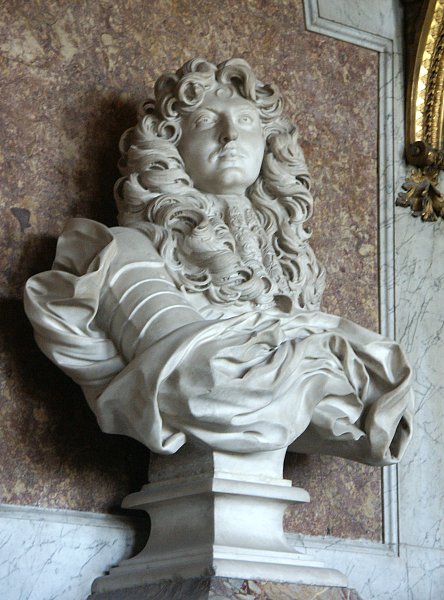With Bernini perhaps the roots of heaven were made of stone. But Bernini and his short sejour in France at the behest of Louis XIV, was something short of heavenly and the divine….
…Nor could Bernini adjust to the customs of the French court. He was used to taking a nap after lunch, a time French courtiers reserved for visits. He was careless about etiquette, and courtiers mocked him for calling the Comte d’Harcourt “Excellence” instead of “Altesse.”
Particularly annoying to him was the habit idle courtiers had of dropping in while he was working on the king’s bust. Dozens came and went each day to watch him perform. The progress of the bust became a major event. The length of the king’s nose, the heaviness of his jaw, and the tilt of his head were discussed with the same urgency as the success of the French armies on the Flanders front.

—“The supreme Baroque image of princely apotheosis”
This quote from John Rupert Martin’s Baroque encapsulates Bernini’s conception–a portrait not of a mere man but a symbol of a divinely ordained, absolutist monarch. As a likeness, it was not very accurate since Louis had small eyes and a low forehead but as a symbolic representation, the noble forehead, the contrapposto turn of the head, the upward gaze–all give a sense of authority and grandeur. According to Howard Hibbard, Bernini’s portrait bust of Francesco I d’Este, Duke of Modena and this heroic bust “set the standard for monarchical portraiture up to the time of the French Revolution”.—Read More:http://www.bluffton.edu/~sullivanm/france/versailles/bernini/louisfourteen.html
Bernini had ordered three blocks of marble, complaining when he received them that they were “cotto”- brittle. He then sketched the king as he went about his daily occupations, playing tennis, at cabinet meetings, and on one occasion as the royal foot was being bled. “Movements reveal all the personal qualities which are his and his alone,” Bernini explained. Once when Louis XIV looked over his shoulder, Bernini said, “sto rubando” -“I am stealing,” and the king replied in Italian, “si, ma e per restituire” -“yes but you will give it back.”
Meanwhile, the same courtiers who had at first treated Bernini as an infallible artistic authority, asking for his advice on everything from a staircase to a tomb, now began to spread rumors about his presumptuous behavior. They said Bernini was a miser who undertipped his servants. They repeated alleged remarks made by him while he was working on the king’s bust, translated as “What I am making is beautiful but the original is really ugly.” They said that after visiting the king’s private apartments in the Louvre, Bernini had aid, non ci sono qui stanze per uomini” -“these are not rooms for men.” Louis XIV cooled toward Bernini after hearing the rumors. He said with regal understatement: “It is true that he does not praise much.”
After forty days the bust was finished. It is a monument to absolutism rather than a faithful likeness. Bernini smoothed the bump on the Bourbon nose and enlarged the king’s small eyes. He tried to wrest from the marble the same effects that the king’s portraitists achieved with color. He modeled a flat curl on the royal forehead and chiseled shadows around the eyes. He regretted not being able to duplicate the king’s long lashes. Bernini was pleased with the result and told an admirer that what Michelangelo had once said also applied to him: “Nelle mie opere caco sangue”- “In my works I shed blood.”





 COMMENTS
COMMENTS